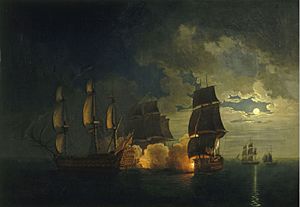Action of 18 October 1782 facts for kids
Quick facts for kids Action of 18 October 1782 |
|||||||
|---|---|---|---|---|---|---|---|
| Part of the American Revolutionary War | |||||||
 Combat du Scipion contre le London, Rossel de Crecy |
|||||||
|
|||||||
| Belligerents | |||||||
| Commanders and leaders | |||||||
| Strength | |||||||
| 2 ships of the line | 1 ship of the line 1 frigate |
||||||
| Casualties and losses | |||||||
| 11 killed 75 wounded 1 ship of the line damaged |
15 killed 46 wounded 1 ship of the line sunk |
||||||
The Action of 18 October 1782 was a small naval battle. It happened during the American Revolutionary War. A French warship, the 74-gun Scipion, was sailing with a 40-gun frigate called Sibylle. Two larger British warships, the 98-gun HMS London and the 74-gun Torbay, chased them.
The Scipion was very clever. It managed to get into a good position. This allowed it to fire along the side of the London. This type of attack is called a raking fire. It caused a lot of damage to the London. This helped the Scipion keep running from the stronger British ships. The Scipion tried to anchor in Samaná Bay. But it hit a rock and sank. The Sibylle managed to get away safely.
The Chase and Battle
On October 17, 1782, during the American Revolutionary War, some British ships were sailing. These included the 98-gun ship of the line HMS London. There was also the 74-gun HMS Torbay. A smaller 14-gun ship, HMS Badger, was with them. They were off the coast of San Domingo when they saw two unknown ships.
The British ships started chasing them. They soon found out they were French ships. One was the 74-gun Scipion. The other was the 40-gun frigate Sibylle. At 2:24 p.m., the London got close enough to the Scipion. Captain James Kempthorne commanded the London. Captain Nicolas Henri de Grimouard commanded the Scipion. The two large ships began to fight. They mostly used their chase guns. Sometimes, the London fired a full broadside.
The Sibylle came to help the Scipion. It attacked the front of the London. This caused a lot of damage to the British ship. The London kept getting closer to the Scipion. Finally, at 8:30 p.m., they were side-by-side. They started firing full broadsides at each other. The battle continued until 8:50 p.m. Then, the two warships crashed together. The front part of the Scipion hit the side of the London.
Being so close, the sailors used small guns like muskets. They fired at the enemy sailors on the upper decks. This caused many injuries. Soon, the Scipion pulled away from the London. It sailed behind the British ship. From there, it fired a powerful raking fire. This shot went from the back to the front of the London. It badly damaged the British ship's ropes and masts. The London was now unable to move well.
While the Scipion was moving around the London, the Torbay finally joined the fight. Captain John Gidoin commanded the Torbay. It started firing at the side of the Scipion. But the damaged London crashed into the Torbay. This left both British ships tangled together.
At 10:20 p.m., the Scipion stopped firing. The Sibylle managed to escape. The British thought the French ship had given up. The London tried to get close to capture it. But its damaged rigging made this impossible. Captain Kempthorne told Captain Gidoin to sail towards the Scipion. But then, the French ship caught a strong gust of wind. It began to sail away.
The British ships quickly got themselves organized again. They started chasing the Scipion once more. They chased it all through the night. They exchanged some shots, but the French ship got further away. By the morning of October 18, the Torbay was about a mile and a half behind the Scipion. By 3:30 p.m., the Torbay had caught up. Captain Gidoin began firing at the Scipion. At this point, the Scipion sailed into Samaná Bay. This bay is in what is now the Dominican Republic. The Scipion tried to anchor there.
The Scipion had bravely escaped a much stronger enemy force. But then, it hit a hidden rock and sank in the bay. The Scipion was completely lost. However, almost all of its crew managed to escape safely.
What Happened Next
King Louis XVI was very impressed. He made Captain Grimouard a count. Grimouard had been hurt in the battle. But he had fought off and escaped the stronger British ships. The King also asked an artist, Auguste-Louis de Rossel de Cercy, to paint the battle.
Captain Kempthorne of the London had to face a special meeting. This was because he couldn't capture the Scipion in the open sea. But he was found innocent of any wrongdoing. He was honorably cleared of all charges.
Ships in the Battle
This table shows details about the ships involved. "Guns" means all the cannons on the ship. "Broadside weight" is the total weight of all the cannonballs fired at once from one side of the ship.
| Ship | Commander | Navy | Guns | Weight (Tons) |
Broadside weight |
Crew | Casualties | ||
|---|---|---|---|---|---|---|---|---|---|
| Killed | Wounded | Total | |||||||
| London | Captain James Kempthorne | 98 | 1,894bm | 1,108 pounds (503 kg) | 743 | 11 | 72 | 83 | |
| Torbay | Captain John Lewis Gidoin | 74 | 1,572bm | 828 pounds (376 kg) | 594 | Unknown | |||
| Scipion | Captain Nicolas Henri de Grimouard | 74 | Unknown | 828 pounds (376 kg) | 734 | 15 | 43 | 58 | |
| Sibylle | Unknown | 40 | 174 pounds (79 kg) | 275 | Unknown | ||||
| Source: | |||||||||

